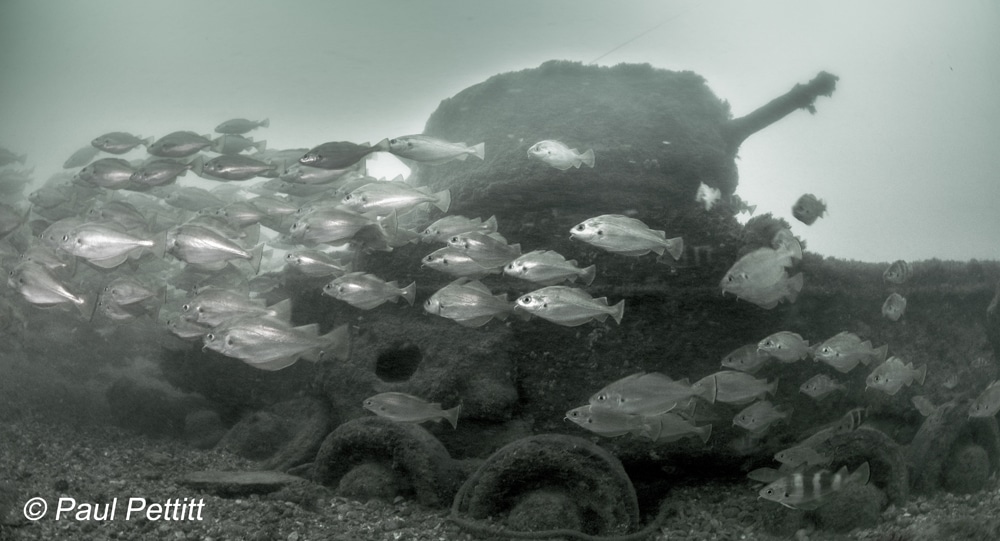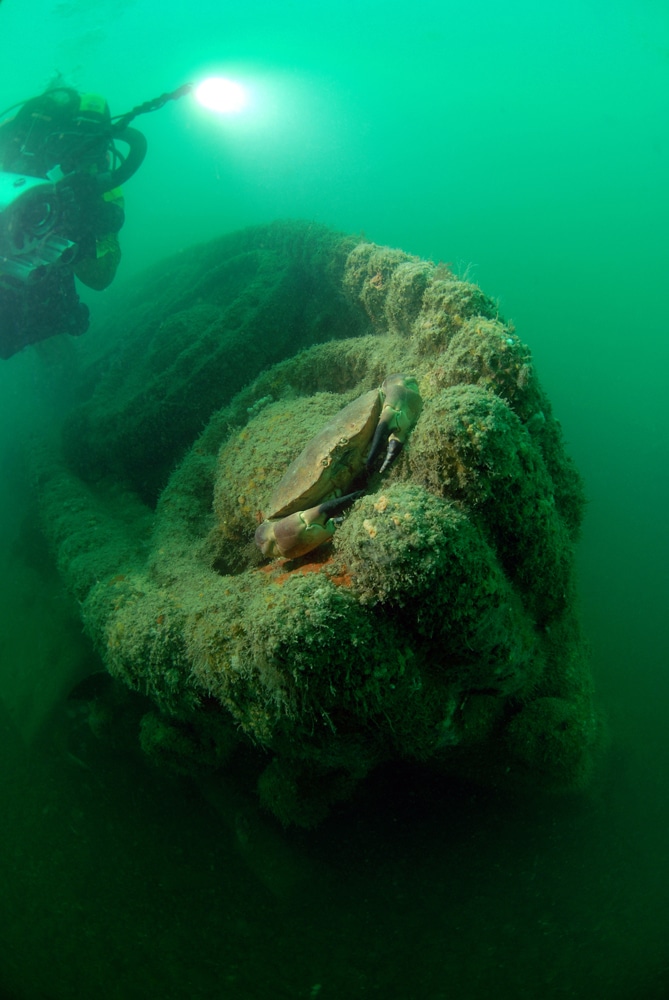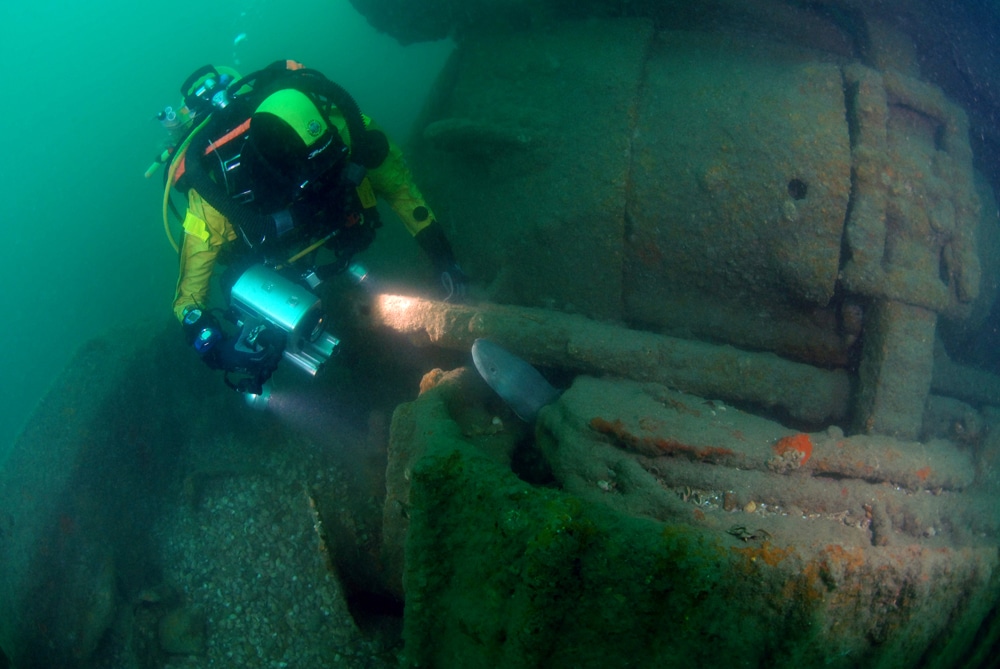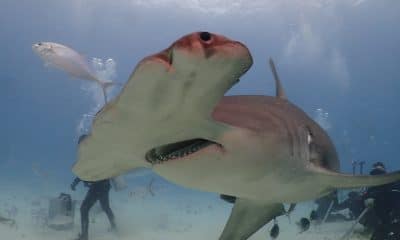News
Historic WWII sites given protection

![]() To mark the 75th anniversary of D-Day, six Second World War concrete structures built as replica landing craft for training, nine sunken army tanks, two armoured bulldozers and components of Mulberry floating harbours in Dorset, Devon and West Sussex are being granted protection by the Department for Digital, Culture, Media and Sport on the advice of Historic England.
To mark the 75th anniversary of D-Day, six Second World War concrete structures built as replica landing craft for training, nine sunken army tanks, two armoured bulldozers and components of Mulberry floating harbours in Dorset, Devon and West Sussex are being granted protection by the Department for Digital, Culture, Media and Sport on the advice of Historic England.
D-Day on 6 June 1944, codenamed Operation Overlord, was the greatest combined land, air and naval operation in history. It was a massive assault by the allies to invade Nazi-occupied Western Europe during the Second World War. 156,000 soldiers from Britain, America, Canada and France landed on the beaches of Normandy together with thousands of vehicles and supplies.
The many rehearsals and training exercises carried out along the coastline of Devon and Dorset together with the great engineering achievements of the Mulberry Harbours contributed to the success of the D-Day landings.
Culture Secretary Jeremy Wright said: “As we commemorate the 75th anniversary of D-Day, it is right that we continue to honour the memory of those who fought for peace in one of the decisive moments of the Second World War. It is also right to recognise the engineering and ingenuity that enabled that offensive. By listing the landing crafts, tanks, bulldozers and floating harbours we can ensure that future generations can learn about this important moment in our history.”
Duncan Wilson, Chief Executive of Historic England said: “Evidence of D-Day planning, rehearsal and the actual operation is all around us, on our coastline and in our waters helping to tell the D-Day Story. These tanks, armoured bulldozers, Mulberry Harbour components and concrete training landing craft are important as a witness to the great engineering achievements and logistical preparations around England’s coast for the largest amphibious invasion ever undertaken, on 6 June 1944. It is vital that we protect them as a memorial for future generations.”
VALENTINE TANK ASSEMBLAGE, STUDLAND BEACH, POOLE BAY, DORSET
(SCHEDULED MONUMENT)
Six weeks before D-Day in April 1944, troops arrived at Studland Beach in Dorset to rehearse an assault codenamed ‘Exercise Smash’. This was watched by Prime Minister Winston Churchill, King George VI and Supreme Allied Commander General Dwight D. Eisenhower from Fort Henry, an observation post built on a small cliff overlooking the bay.
Seven army tanks known as Duplex Drive (DD) Valentine tanks were lost during this exercise which went badly wrong. The Valentine was modified to be a ‘floating’ or amphibious tank that could leave its landing ship further out from shore than other tanks. However, during the exercise, these tanks sank with the loss of six crewmen shortly after driving off their landing craft. They ran into immediate difficulty when a sudden change in the weather adversely affected sea conditions. A valuable lesson was learned that these tanks couldn’t survive being launched too far from a beach and consequently on D-Day itself the tanks were released in shallow water.
The Valentine tanks in Poole Bay represent the largest surviving group of their type anywhere in the world.
SECOND WORLD WAR TANKS & BULLDOZERS, SELSEY BILL, WEST SUSSEX
(SCHEDULED MONUMENT)
In June 1944, the Allies opened a second front in Europe with Operation Neptune, comprising a largely amphibious invasion. In preparation for the assault, the 286-ton landing craft LCT(A)2428 was loaded with two Centaur cruiser tanks designed to fire at concrete targets such as pillboxes, two armoured D7 bulldozers designed to protect both the driver and the engine while clearing the invasion beaches of obstacles, one 4X4 car and a jeep. All the vehicles were lost on the night of 5/6 June when the landing craft broke down in the Solent while on route to the D-Day landings in Normandy. The vessel was taken under tow but capsized, spilling into the sea its cargo of tanks and armoured bulldozers intended to support the 3rd Canadian Infantry Division landing at Juno Beach. Sometime afterwards, the upturned vessel was deliberately sunk by gunfire from its tug, several miles to the east, off Selsey Bill in West Sussex. These armoured vehicles represent the only surviving group of their type in north-west Europe.
PHOENIX CAISSON (OUTER) OFF PAGHAM HARBOUR, WEST SUSSEX (SCHEDULED MONUMENT)
Mulberry Harbours were considered to be a major technological and engineering achievement of their time and contributed to the success of the D-Day landings. Designed and constructed by British military engineers during the Second World War, these huge artificial floating harbours were used by the allies to rapidly land enormous amounts of supplies and equipment in Normandy following the invasion.
The component parts were towed by tugs across the Channel, assembled by the military then sunk off Normandy to form a sheltered harbour to protect unloading ships. The Mulberries consisted of four major component parts and each had a code-name: Gooseberry (a network of artificial breakwaters), Bombardon (floating breakwaters), Whale (floating piers) and Phoenix (sunken breakwaters).
The outer or far Mulberry off Pagham Harbour which has been protected is a Phoenix caisson and it is a rare type of steel reinforced concrete unit that functioned as a sunken breakwater. Phoenix units varied in size between 2000 and 6000 tons. In June 1944 this particular unit was ‘parked’ off Pagham awaiting passage to Normandy. Its ballast tanks were pumped out to re-float it but as its tug wasn’t ready, the unit was re-sunk. However, during stormy weather, it swung around in the tide and became so damaged that it became unusable. It has remained in situ ever since.
PHOENIX CAISSON (INNER) OFF PAGHAM, WEST SUSSEX (SCHEDULED MONUMENT)
A rare concrete pier off Pagham has also been granted protection. Part of the Mulberry Harbour, this comprises a steel reinforced concrete platform which was designed to connect to offshore pontoons allowing more than one ship to unload its cargo at any one time. It is not yet clear how this sunken pier came to be located in the shallow waters off Pagham, but it is in an area commonly known by mariners as the ‘park’ which contains a large number of submerged or ‘parked’ Second World War components that were associated with Mulberry Harbour operations.
SECOND WORLD WAR CONCRETE REPLICA LANDING CRAFT AND TRAINING AREA, BRAUNTON BURROWS, DEVON – LISTED GRADE II
Six Second World War replica landing craft installations made of concrete and used for training American troops at Braunton Burrows in Devon have been protected. From September 1943, the North Devon coast became an Assault Training Center for American forces as part of the preparations for an allied attack on the Normandy beaches. Concrete replica landing craft were based on a 1942 American modification of the British Tank Landing Craft and were designed to represent the top deck of the craft with its front ramp lowered so troops could practice the embarking and disembarking of vehicles and personnel in advance of the D-Day landings. Additional aprons were added at the back of the craft and six foot high metal poles at the base edges supported either canvas or corrugated-tin screens to represent the sides of the craft.
The training structures were abandoned and a large number demolished in the late 20th century. A memorial service is held on 6 June each year at the replica craft structures at Braunton Burrows to recognise and remember the important role that the members of the allied forces played in the liberation of Europe.
A further concrete structure newly listed at Grade II at the Assault Training Center, to the north of the landing craft, illustrates the range of facilities offered here. The practice rocket, or ‘Bazooka’, wall was built deep within the sand dunes in 1943, a target butt for the Allied forces. A rare survival of its type, the wall is largely intact and the visible repairs provide evidence of its use.
The majority of the newly protected structures have been identified by military enthusiasts the Friends of the Assault Training Center. They will be working with Historic England, North Devon Area of Outstanding Natural Beauty and Christie Estates to conserve and manage them after the commemoration of the 75th anniversary of D-Day on 6 June to ensure they are accessible for more people to enjoy.
For more information visit the Historic England website by clicking here.
Blogs
Northern Red Sea Reefs and Wrecks Trip Report, Part 3: The Mighty Thistlegorm

Jake Davies boards Ghazala Explorer for an unforgettable Red Sea diving experience…
Overnight, the wind picked up, making the planned morning dive a bit bumpy on the Zodiacs to the drop point on Thomas Reef. There, we would dive along the reef before descending through the canyon and then passing under the arch before ascending the wall with a gentle drift. The site provided great encounters with more pelagic species, including shoals of large barracuda, tuna, and bigeye trevally.
Once back on the boat, it was time to get everything tied down again as we would head back south. This time, with the wind behind us, heading to Ras Mohammed to dive Jackfish Alley for another great gentle drift wall dive before then heading up the coast towards the Gulf of Suez to moor up at the wreck of the Thistlegorm. This being the highlight wreck dive of the trip and for many onboard, including myself, it was the first time diving this iconic wreck. I had heard so much about the wreck from friends, and globally, this is a must on any diver’s list. Fortunately for us, there was only one other boat at the site, which was a rarity. A great briefing was delivered by Ahmed, who provided a detailed background about the wreck’s history along with all the required safety information as the currents and visibility at the site can be variable.

Kitting up, there was a lot of excitement on deck before entering the water and heading down the shoreline. Descending to the wreck, there was a light northerly current which reduced the visibility, making it feel more like the conditions that can be found off the Welsh coast. At 10m from the bottom, the outline of the wreck appeared as we reached the area of the wreck which had been bombed, as our mooring line was attached to part of the propeller shaft. Arriving on deck, instantly everywhere you looked there were many of the supplies which the ship was carrying, including Bren Carrier tanks and projectiles that instantly stood out.

We headed around the exterior, taking a look at the large propeller and guns mounted on deck before entering the wreck on the port side to take a look in the holds. It was incredible to see all the trucks, Norton 16H, and BSA motorcycles still perfectly stacked within, providing a real snapshot in time.

Overall, we had four dives on the Thistlegorm, where for all of the dives we were the only group in the water, and at times, there were just three of us on the whole wreck, which made it even more special, especially knowing that most days the wreck has hundreds of divers. Along with the history of the wreck, there was plenty of marine life on the wreck and around, from big green turtles to batfish, along with shoals of mackerel being hunted by trevally. Some unforgettable dives.

The final leg of the trip saw us cross back over the Suez Canal to the Gobal Islands where we planned to stay the night and do three dives at the Dolphin House for the potential of sharing the dive with dolphins. The site, which included a channel that was teeming with reef fish, especially large numbers of goatfish that swam in large shoals along the edge of the reef. These were nice relaxing dives to end the week. Unfortunately, the dolphins didn’t show up, which was okay as like all marine life they are difficult to predict and you can’t guarantee what’s going to be seen. With the last dive complete, we headed back to port for the final night where it was time to clean all the kit and pack before the departure flight the next day.

The whole week from start to finish on Ghazala Explorer was amazing; the boat had all the facilities you need for a comfortable week aboard. The crew were always there to help throughout the day and the chefs providing top quality food which was required after every dive. The itinerary providing some of the best diving with a nice mixture of wreck and reef dives. I would recommend the trip to anyone, whether it’s your first Red Sea liveaboard in the Red Sea or you’re revisiting. Hopefully, it’s not too long before I head back to explore more of the Red Sea onboard Ghazala Explorer.

To find out more about the Northern Red Sea reef and wrecks itineraries aboard Ghazala Explorer, or to book, contact Scuba Travel now:
Email: dive@scubatravel.com
Tel: +44 (0)1483 411590
Photos: Jake Davies / Avalon.Red
Blogs
Northern Red Sea Reefs and Wrecks Trip Report, Part 2: Wall to Wall Wrecks

Jake Davies boards Ghazala Explorer for an unforgettable Red Sea diving experience…
The second day’s diving was a day full of wreck diving at Abu Nuhas, which included the Chrisoula K, Carnatic, and Ghiannis D. The first dive of the day was onto the Chrisoula K, also known as the wreck of tiles. The 98m vessel remains largely intact where she was loaded with tiles which can be seen throughout the hold. The stern sits at 26m and the bow just below the surface. One of the highlights of the wreck is heading inside and seeing the workroom where the machinery used for cutting the tiles are perfectly intact. The bow provided some relaxing scenery as the bright sunlight highlighted the colours of the soft coral reef and the many reef fish.

Following breakfast, we then headed to the next wreck, which was the Carnatic. The Carnatic is an 89.9m sail steamer vessel that was built in Britain back in 1862. She ran aground on the reef back in 1869 and remains at 27m. At the time, she was carrying a range of items, including 40,000 sterling in gold. An impressive wreck where much of the superstructure remains, and the two large masts lay on the seafloor. The wooden ribs of the hull provide structures for lots of soft corals, and into the stern section, the light beams through, bouncing off the large shoals of glass fish that can be found using the structure as shelter from the larger predators that are found outside of the wreck.

The final wreck at Abu Nuhas was the Ghiannis D, originally called ‘Shoyo Maru,’ which was 99.5m long and built in Japan back in 1969 before becoming a Greek-registered cargo ship in 1980. The ship then ran aground on the reef on April 19th, 1983, and now sits at the bottom at a depth of 27m. Heading down the line, the stern of the ship remains in good condition compared to the rest of the hull. The highlight of the wreck, though, is heading into the stern section and down the flights of stairs to enter the engine room, which remains in good condition and is definitely worth exploring. After exploring the interior section of the ship, we then headed over to see the rest of the superstructure, where it’s particularly interesting to see the large table corals that have grown at the bow relatively quickly considering the date the ship sank. After surfacing and enjoying some afternoon snacks, we made sure everything was strapped down and secured as we would be heading north and crossing the Gulf of Suez, where the winds were still creating plenty of chop.

The next morning, it was a short hop to Ras Mohammed Nature Reserve for the next couple of days of diving. The 6am wake-up call came along with the briefing for the first site we would be diving, which was Shark & Yolanda. The low current conditions allowed us to start the dive at Anemone City, where we would drift along the steep, coral-filled wall. These dives involved drifts, as mooring in Ras Mohammed wasn’t allowed to protect the reefs. As a dive site, Shark & Yolanda is well-known and historically had a lot of sharks, but unfortunately not so many in recent years, especially not so early in the season. However, there was always a chance when looking out into the blue.

The gentle drift took us along the steep walls of the site, with plenty of anemone fish to be seen and a huge variety of corals. It wasn’t long into the dive before we were accompanied by a hawksbill turtle, who drifted with us between the two atolls before parting ways. Between the two reefs, the shallow patch with parts of coral heads surrounded by sand provided the chance to see a few blue-spotted stingrays that were mainly resting underneath the corals and are always a pleasure to see. With this being the morning dive, the early sunlight lit up the walls, providing tranquil moments. Looking out into the blue, there was very little to be seen, but a small shoal of batfish shimmering underneath the sunlight was a moment to capture as we watched them swim by as they watched us.

Towards the end of the dive, we stopped at the wreck of the Jolanda where the seafloor was scattered with toilets from the containers it was carrying. This provided a unique site to make a safety stop, which was also accompanied by a large barracuda slowly swimming by, along with a hawksbill turtle calmly swimming over the reef as the sun rays danced in the distance.
For the next dive, we headed north to the Strait of Tiran to explore the reefs situated between Tiran Island and Sharm El Sheik, which were named after the British divers who had found them. We started on Jackson before heading to Gordons Reef, where we also did the night dive. All the atolls at these sites provided stunning, bustling coral reefs close to the surface and steep walls to swim along, which always provided the opportunity to keep an eye out for some of the larger species that can be seen in the blue. Midwater around Jackson Reef was filled with red-toothed triggerfish and shoals of banner fish, which at times were so dense that you couldn’t see into the blue. Moments went by peacefully as we enjoyed the slow drift above the reef, watching these shoals swim around under the mid-afternoon sun.

The night dive at Gordon’s Reef was mainly among the stacks of corals surrounded by sand, which was great to explore under the darkness. After some time circling the corals, we came across what we were really hoping to find, and that was an octopus hunting on the reef. We spent the majority of the dive just watching it crawl among the reef, blending into its changing surroundings through changes in colour and skin texture. It’s always so fascinating and captivating to watch these incredibly intelligent animals, in awe of their ability to carry out these physical changes to perfectly blend into the reef. Before we knew it, it was time to head back to the boat to enjoy a well-deserved tasty dinner prepared by the talented chefs onboard.
Check in for the 3rd and final part of this series from Jake tomorrow!
To find out more about the Northern Red Sea reef and wrecks itineraries aboard Ghazala Explorer, or to book, contact Scuba Travel now:
Email: dive@scubatravel.com
Tel: +44 (0)1483 411590
Photos: Jake Davies / Avalon.Red
-

 News3 months ago
News3 months agoHone your underwater photography skills with Alphamarine Photography at Red Sea Diving Safari in March
-

 News3 months ago
News3 months agoCapturing Critters in Lembeh Underwater Photography Workshop 2024: Event Roundup
-

 Marine Life & Conservation Blogs2 months ago
Marine Life & Conservation Blogs2 months agoCreature Feature: Swell Sharks
-

 Blogs2 months ago
Blogs2 months agoMurex Resorts: Passport to Paradise!
-

 Blogs2 months ago
Blogs2 months agoDiver Discovering Whale Skeletons Beneath Ice Judged World’s Best Underwater Photograph
-

 Gear Reviews3 months ago
Gear Reviews3 months agoGear Review: Oceanic+ Dive Housing for iPhone
-

 Marine Life & Conservation2 months ago
Marine Life & Conservation2 months agoSave the Manatee Club launches brand new webcams at Silver Springs State Park, Florida
-

 News3 months ago
News3 months agoWorld’s Best Underwater Photographers Unveil Breathtaking Images at World Shootout 2023
















